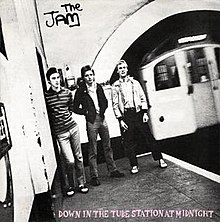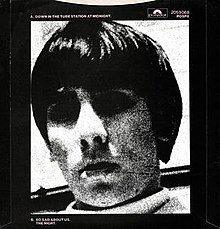Down in the Tube Station at Midnight
| "Down in the Tube Station at Midnight" | ||||
|---|---|---|---|---|
 | ||||
| Single by The Jam | ||||
| from the album All Mod Cons | ||||
| B-side | "So Sad About Us / The Night" | |||
| Released | 13 October 1978 | |||
| Genre | Mod Revival | |||
| Label | Polydor (UK) | |||
| Songwriter(s) | Paul Weller | |||
| Producer(s) | Vic Coppersmith-Heaven | |||
| The Jam singles chronology | ||||
| ||||
| Back cover | ||||
 Keith Moon, who died shortly before the single's release | ||||
"Down in the Tube Station at Midnight" is a single by The Jam, and was the second single from their third album, All Mod Cons. Released in October 1978, it reached No. 15 in the UK Singles Chart.[1] The single was backed by a cover version of The Who's song "So Sad About Us", and the song "The Night", written by Bruce Foxton.
Production
Originally Paul Weller had wanted to exclude the song from the All Mod Cons album,[2] on the grounds that the arrangement had not sufficiently developed during the recording sessions.[3] He was persuaded to include it by the record's producer Vic Coppersmith-Heaven.[3][4]
Lyrical theme and musical composition
The song tells the story of an unnamed narrator travelling on his own who enters a London Underground tube station at midnight to get the last train home, where he is attacked by a gang of men who 'smell like pubs, and Wormwood Scrubs, and too many right-wing meetings' as he buys a ticket from an automated machine.[5] The song starts with the atmospheric sounds of a London Underground station, then a tense, syncopated beat carried by the bass guitar. The lyrics are sentimental, contrasting the warmth of home and domestic life with the dangers of 1970s London's urban decay and casual late-night violence. Tension is heightened by a heartbeat audio effect in the left stereo channel at points during the song.[6]
Cover art
The front cover photograph was taken at Bond Street tube station, on the westbound Central line. On the back cover was a portrait photograph of Keith Moon who had died a month prior to the single's release.[7] The Who's "So Sad About Us" was included as a tribute to Moon.[8]
Cover versions
- Carter the Unstoppable Sex Machine released a version of it as the B-side of their single release "Do Re Me So Far So Good" (1992).
- The Bad Shepherds covered the song in their album Yan, Tyan, Tethra, Methra! (2009).[9]
References
- ^ "Artists - The Jam". Rolling Stone. 8 November 2001. Archived from the original on 8 October 2012. Retrieved 7 November 2020.
- ^ Alexander, Phil (12 August 2013). "The Jam: All Mod Cons Revisited". Mojo. Retrieved 7 November 2020.
- ^ a b Buskin, Richard (1 March 2007). "Classic Tracks: The Jam 'The Eton Rifles'". Sound on Sound. Retrieved 7 November 2020.
- ^ "How The Jam almost didn't record one of their biggest hits". Radio X. Retrieved 2 November 2020.
- ^ "Down in the Tube Station at Midnight by The Jam". Songfacts. Retrieved 7 November 2020.
- ^ Taysom, Joe Taysom·October 6, 2020 (6 October 2020). "The reason why the BBC banned The Jam's anti-racism song 'Down in the Tube Station at Midnight'". Far Out. Retrieved 7 November 2020.
{{cite web}}: CS1 maint: multiple names: authors list (link) CS1 maint: numeric names: authors list (link) - ^ "Down in the Tube Station at Midnight". Snapgalleries.com. 19 April 2016. Retrieved 7 November 2020.
- ^ "The Jam - Down in the Tube Station at Midnight". Radio X. Retrieved 7 November 2020.
- ^ "Yan, Tyan, Tethera, Methera!". The Bad Shepherds. 10 April 2009. Retrieved 7 November 2020.
